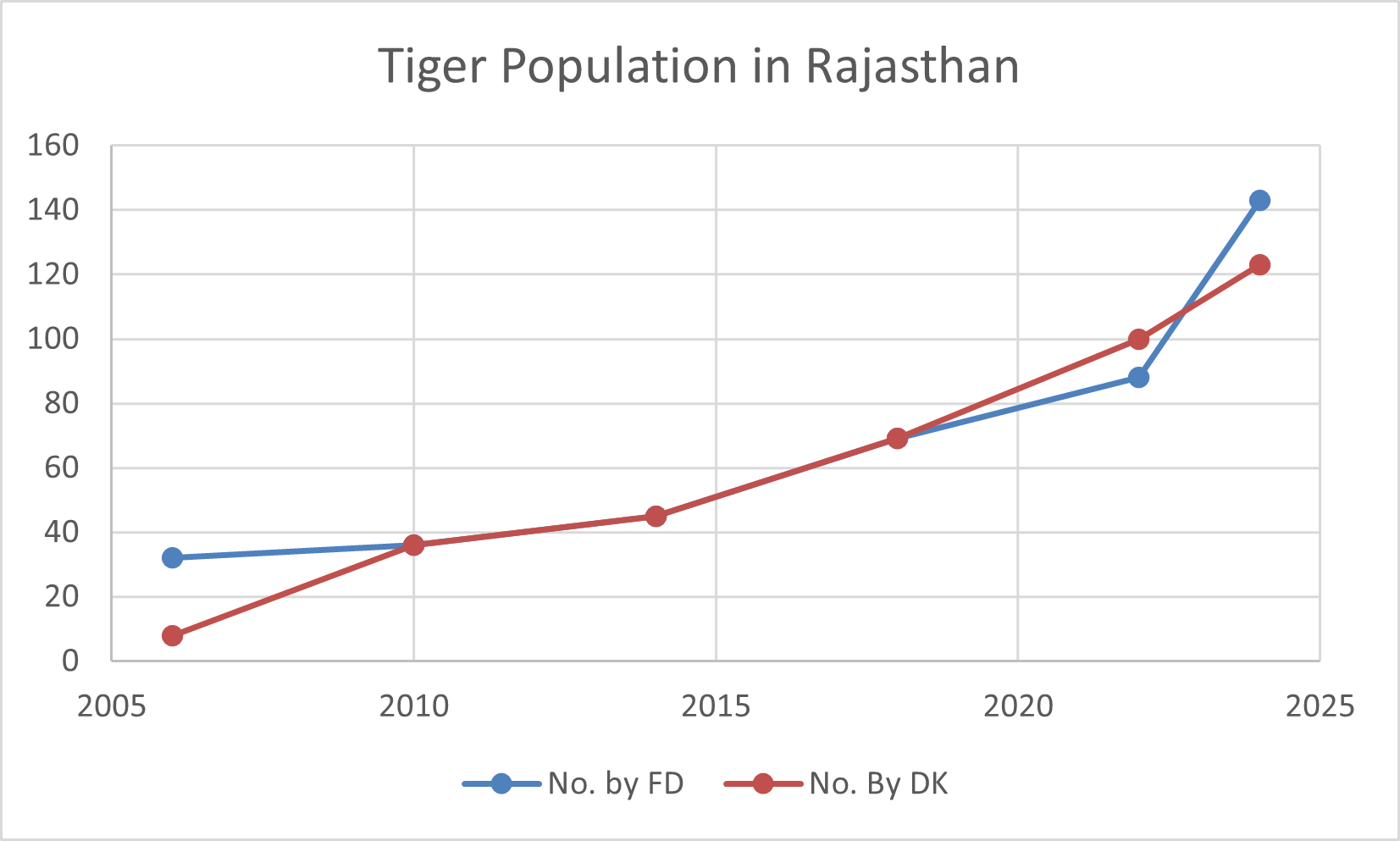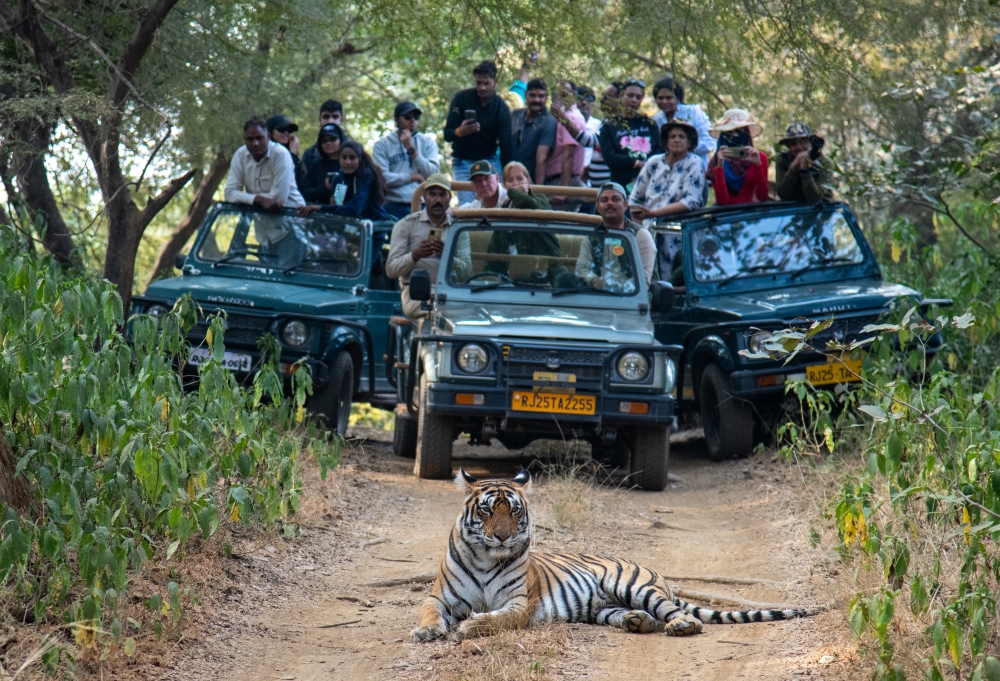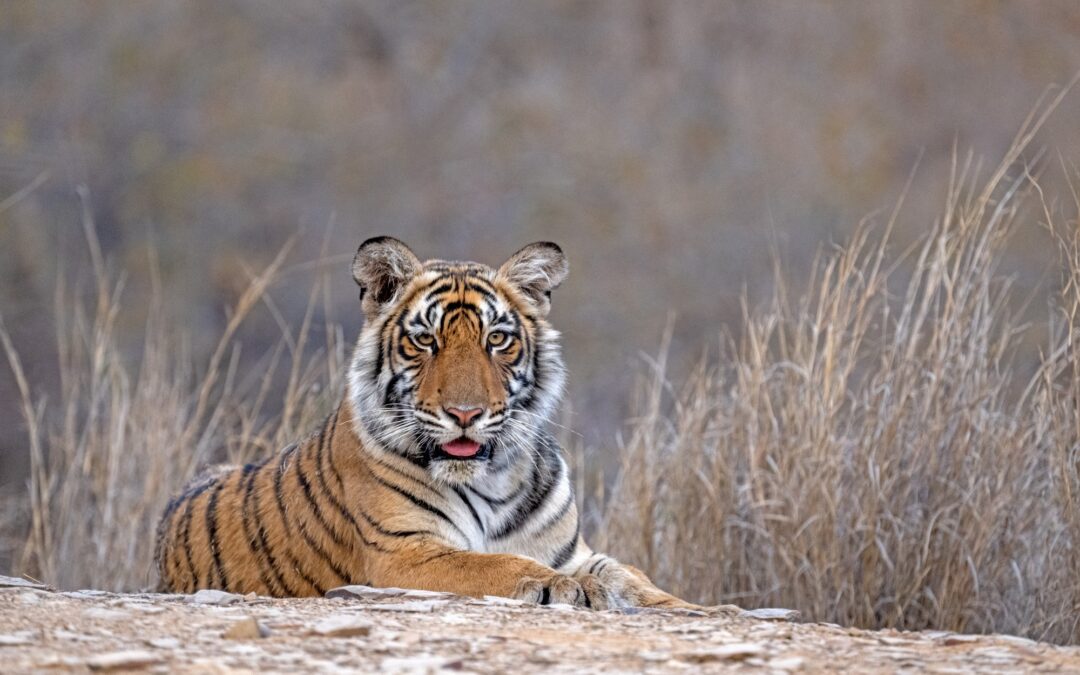Fateh Singh Rathore once predicted that those who criticize the tigers of Ranthambhore would eventually come to appreciate their value and benefit from their conservation, and that day has indeed arrived. We now witness this shift in perspective firsthand. The direct benefits of tourism have transformed views on tiger reserves, changing the opinions of those who once believed these reserves hindered local community development. The success of Ranthambhore has even inspired neighbouring districts, such as Kota and Bundi, to develop their forests into tiger reserves, further advancing conservation efforts.
Over the past two decades, the status of tigers in Rajasthan has seen remarkable improvement. The dark period of 2005, when renowned journalist Jay Mazoomdaar of the Indian Express exposed the complete loss of tigers in Sariska, is now a part of history. Mazoomdaar’s groundbreaking report also highlighted Tiger Watch’s 2004 findings, which revealed that Ranthambhore had lost 50% of its tiger population, leaving only around 25 tigers in the park.
Initially, both the news report and Tiger Watch’s findings were dismissed as agenda-driven false claims. The government attempted to deny, discredit, and obscure these inconvenient truths. To establish the exact number of tigers in Ranthambhore, various agencies conducted surveys using different methods, which produced varying results. However, a consensus emerged that Ranthambhore had 11 adult females, 2 adult males, 3 sub-adult males, and 2 sub-adult females, with no cubs at that time. This total of 18 tigers represented the entire tiger population in Rajasthan.
Ultimately, these revelations catalysed significant conservation efforts, leading to the remarkable recovery of the tiger population in Rajasthan today.
Tiger Numbers in Rajasthan
Before India’s independence, tigers were spread across 17 princely states and one British administrative state in Rajasthan. Only Bikaner and Jaisalmer princely states were devoid of tigers. Rough estimates indicate that tigers once roamed over 50,000 sq.km in the state. However, by 2005, their presence was confined to the less than 400 sq.km area of Ranthambhore National Park, a mere 0.8% of their original habitat.
The scenario changed due to five strong reasons, leading to a paradigm shift:
- Focused Government Efforts: After the global humiliation following the revelation of the tiger crisis, the government, through the forest department, intensified efforts to save tigers, creating the National Tiger Conservation Authority (NTCA) and Wildlife Crime Control Bureau (WCCB).
- Advancements in Science and Technology: The use of camera traps, GPS tracking, and other technologies allowed for better monitoring and protection of tigers.
- Increased Awareness and Activism: Growing public awareness and social media activism pressured authorities to work harder for tiger conservation. Both mainstream and social media played significant roles in this transformation.
- Crucial Role of NGOs: Non-governmental organizations and associated individuals made substantial contributions to tiger conservation efforts.
- Impact of tourism: The growth of safari tourism and the resulting influx of significant economic investment have positively impacted the tiger populations in the landscape. Increased revenue from tourism has contributed to enhanced conservation efforts, improved habitat management, and greater protection measures, all of which support the growth and stability of tiger population.
Achievements
- Tiger Population Growth: The tiger population in Rajasthan increased from 18 in 2006 to 123 in 2024, representing a 583.33% growth over 18 years.
- Expansion of Tiger Reserves: The number of tiger reserves increased from two in 2006 to five, with the total area of these reserves expanding from 2,200 sq.km to 5,975.48 sq.km, a 2.7-fold increase.
- Geographical Spread: In 2005, tigers were confined to Sawai Madhopur district. Today, they have spread to the districts of Sawai Madhopur, Karauli, Dholpur, Bundi, Kota, and Alwar. Tigers occasionally visit Jaipur, Tonk, Jhalawar, Chittorgarh, and Bhilwara districts.
- Increased Habitat Area: Tigers now occupy 1,700-2,000 sq.km of the designated 6,000 sq.km area in Rajasthan, up from 400 sq.km in 2005. This represents 30% of the designated area.

Graph 1: The graph depicts two lines: a blue line representing government data and a red line representing Tiger Watch data. Both lines are closely aligned throughout the period shown. However, notable differences occur in two specific timeframes. In the initial days, the forest department’s estimates were higher. More recently, the forest department’s estimates did not include cubs, resulting in a discrepancy. This year, the forest department’s estimate is slightly higher by ten individuals.
Conclusion
It is encouraging to witness the reestablishment of a viable principal tiger population in Ranthambhore, complemented by the development of 2-3 surrounding meta-populations. These meta-populations are crucial for enhancing genetic diversity by facilitating the introduction of new genetic material into the main population. Currently, Dholpur, Bundi, and Kailadevi serve as key meta-populations within this network. Notably, Bundi has significant potential to evolve into a principal population in the future, further bolstering the genetic health and stability of the tiger populations in the region.
The future outlook for Rajasthan appears promising. To sustain and enhance this positive trend, it is imperative that the government prioritizes the development of the Kumbhalgarh habitat as a potential future tiger population site. Expanding and enhancing tiger habitats in this manner will contribute significantly to the long-term conservation and stability of tiger populations in the area.

A jeep carrying tourists on a tiger safari in Ranthambore National Park. The park’s tiger population has been steadily increasing, attracting a growing number of tourists from around the world.
Tourism Boom in Ranthambhore: From Humble Beginnings to a Thriving Industry
In recent years, tourism in Ranthambore has surged to new heights, accompanied by increased local involvement. Both government policies and individual enthusiasm have significantly contributed to this growth. Many local residents have invested in building hotels and homestays. The government has supported the establishment of small enterprises, which marks a notable achievement for the local community. Additionally, in the last 10-12 years many local community people bought safari vehicles through loans represents another significant development. Public participation is key to this effort. The tourism officials who have implemented these policies deserve commendation, as do the Forest Department officials for recruiting local residents as guides. These efforts are commendable, and several initiatives are underway to enhance guide training.
As we proceed with these important developments, we must remain mindful of the area’s carrying capacity. Reflecting on the history of tourism development in Ranthambore, it is evident how far we have come, and this progress deserves recognition.

Tourist Numbers in Ranthambhore Indicate What?
- Visitor Increase and Revenue Growth: In the year 2023-24, a total of 6.5 lakh tourists visited Ranthambhore, generating a revenue of 60.3 crore INR. In comparison, 37 years ago, in 1987-88, the park was visited by 15,000 tourists, earning 4.12 lakh INR. This indicates a 433-fold increase in the number of tourists and a 1500-fold increase in revenue.
- First Significant Leap: The first substantial increase in earnings occurred during G.V. Reddy’s tenure in 1997-98, when revenue quadrupled from 10 lakh to 40 lakh INR, eventually reaching 80-90 lakh INR during his time.
- Second Significant Jump: The next major increase happened in 2004 under G.S. Bhardwaj, with revenue reaching 2 crore INR.
- Third Major Increase: In 2010-11, during RP Gupta’s tenure, revenue jumped from 3 crore to 6 crore INR.
- Latest Significant Growth: The most recent significant increase occurred in 2015-16, with earnings reaching 17-18 crore INR. It was time of Y K Sahu.
- COVID-19 Impact: The lowest earnings were recorded in 2020-21 during the COVID-19 pandemic, but even then, the revenue was 12-13 crore INR. In the last three years, revenue has surged, reaching 60 crore INR.
- Tourism Management: Fiscal management and a liberal approach have enhanced tourism, although it’s important to acknowledge that Ranthambhore National Park utilizes the tourism area quota of Kailadevi Division of RTR.
- Student Quota Cancellation: It is unfortunate that the student quota was discontinued in 2019. Previously, students were charged half the fee, but this concession is no longer available.
- Actual Visitors: In 2023-24, 654,786 tourists visited the park, indicating that the park operated at 67.64% of its total capacity (967,938 tourists can visit in a year).

Prediction
The growth in the number of tourists over 37 years is significant, increasing from 15,000 to 6,50,000, which corresponds to an annual average growth rate of around 10.72%. Based on this growth rate, it is projected that approximately 1.8 million tourists will demand safari after ten years. But on the close analysis of 37 years data indicated that compound annual growth rate was 16.65% in the first decade, in the second decade 12.87%, in the third decade it is 7.04% and in the last seven years period it was 4.14%. it shows decline and some control by the system. So, if the trend of a 4.14% CAGR continues over the next decade, the projected number of tourists would be approximately 967,720.
Significant tourism pressure is anticipated in the future, necessitating the development of additional avenues and the expansion of protected areas. The current trajectory of tourism is unsustainable, requiring careful regulation to mitigate its impact. Simultaneously, it is crucial to address the aspirations of local communities and ensure that conservation efforts align with both ecological needs and socio-economic benefits.


sir, its commendable, I got few pts for my fav park
1. stop VIP gypsies…kindly do that. .its a shame for those who are paying so much, and VIP gypsy comes and goes ahead of you and can visit any zone. it’s a very bad precedent
2. increase the tourism area so the more area is covered, and animals remain safe from poachers
3. avoid overcrowding of vehicles, even the pic above sees the overcrowding, my advice is to restrict the canters to 2 per zone, and gypsies to max 8
4. strictness as drivers do in MP parks the never go near to the animal, and drivers and guides here start fighting among each other
5. develop center points in parks for bfast and increase the safari timings as in all MP and Maharashtra parks.
6. pick up point should be developed as the drivers pick guest from there hotels and reach pick up point where guide is ready with pass,, e.g. Bandhavgarh
7.the 3-month advance booking has started but there is no gypsy for zone 1to 5 till mid April…if this rule is brought into force, then all the previous booking should be cancelled
8.develop govt souvenir kiosks
9.most imp, is ban carrying of mobile ..we are waiting for incident like which happened in tadoba when a guest fell down from the vehicle while taking a selfie with tiger
Dear ALL, it’s just easy to learn :
> set up the National-Park-Rules of TADOBA – than, there is much more freedom for:
a) Driver & Guide
b) Tourists
c) and the animals !
— All people has to remove the Smartphone before enter the Park ! that’s great !
— Driver and Guide are from local communittee (not related to the Wildlife-Dep)
Driver and Guide are responsible, that tourists do follow the few powerful rules !
— a few cars has to be on the spot; after a while, they move out; other cars come into
— you can select : normal tour / half-day or full day-tour for a much lower price-level compare to Ranthambhore and other parks !
This all is now under the law of Maharastrah for all Parks overthere ! its a master-key for all other parks in India ! the only way to preserve Nature and fulfill peoples wish to enjoy a wildlife-habitat in a best way !
This with greetings to all wildlife-lovers in India – Dieter Gutmann